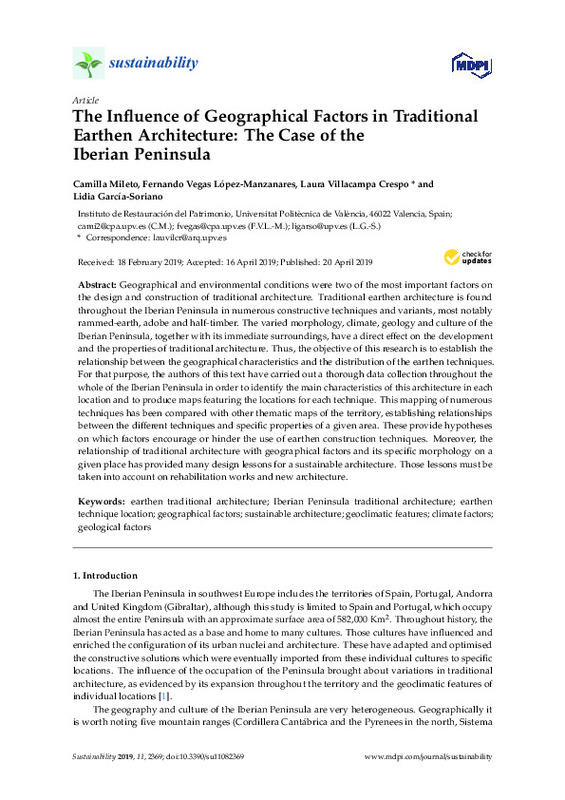JavaScript is disabled for your browser. Some features of this site may not work without it.
Buscar en RiuNet
Listar
Mi cuenta
Estadísticas
Ayuda RiuNet
Admin. UPV
The Influence of Geographical Factors in Traditional Earthen Architecture: The Case of the Iberian Peninsula
Mostrar el registro sencillo del ítem
Ficheros en el ítem
| dc.contributor.author | Mileto, Camilla
|
es_ES |
| dc.contributor.author | Vegas López-Manzanares, Fernando
|
es_ES |
| dc.contributor.author | Villacampa Crespo, Laura
|
es_ES |
| dc.contributor.author | García-Soriano, Lidia
|
es_ES |
| dc.date.accessioned | 2021-02-24T04:31:40Z | |
| dc.date.available | 2021-02-24T04:31:40Z | |
| dc.date.issued | 2019-04-02 | es_ES |
| dc.identifier.uri | http://hdl.handle.net/10251/162241 | |
| dc.description.abstract | [EN] Geographical and environmental conditions were two of the most important factors on the design and construction of traditional architecture. Traditional earthen architecture is found throughout the Iberian Peninsula in numerous constructive techniques and variants, most notably rammed-earth, adobe and half-timber. The varied morphology, climate, geology and culture of the Iberian Peninsula, together with its immediate surroundings, have a direct effect on the development and the properties of traditional architecture. Thus, the objective of this research is to establish the relationship between the geographical characteristics and the distribution of the earthen techniques. For that purpose, the authors of this text have carried out a thorough data collection throughout the whole of the Iberian Peninsula in order to identify the main characteristics of this architecture in each location and to produce maps featuring the locations for each technique. This mapping of numerous techniques has been compared with other thematic maps of the territory, establishing relationships between the different techniques and specific properties of a given area. These provide hypotheses on which factors encourage or hinder the use of earthen construction techniques. Moreover, the relationship of traditional architecture with geographical factors and its specific morphology on a given place has provided many design lessons for a sustainable architecture. Those lessons must be taken into account on rehabilitation works and new architecture. | es_ES |
| dc.description.sponsorship | This work is part of the research project "Restoration and rehabilitation of traditional earthen architecture in the Iberian Peninsula. Guidelines and tools for a sustainable intervention", funded by the Spanish Ministry of Economy and Competitiveness (Ref.: BIA2014-55924-R; main researchers: Camilla Mileto and Fernando Vegas Lopez-Manzanares). | es_ES |
| dc.language | Inglés | es_ES |
| dc.publisher | MDPI AG | es_ES |
| dc.relation.ispartof | Sustainability | es_ES |
| dc.rights | Reconocimiento (by) | es_ES |
| dc.subject | Earthen traditional architecture | es_ES |
| dc.subject | Iberian Peninsula traditional architecture | es_ES |
| dc.subject | Earthen technique location | es_ES |
| dc.subject | Geographical factors | es_ES |
| dc.subject | Sustainable architecture | es_ES |
| dc.subject | Geoclimatic features | es_ES |
| dc.subject | Climate factors | es_ES |
| dc.subject | Geological factors | es_ES |
| dc.subject.classification | COMPOSICION ARQUITECTONICA | es_ES |
| dc.title | The Influence of Geographical Factors in Traditional Earthen Architecture: The Case of the Iberian Peninsula | es_ES |
| dc.type | Artículo | es_ES |
| dc.identifier.doi | 10.3390/su11082369 | es_ES |
| dc.relation.projectID | info:eu-repo/grantAgreement/MINECO//BIA2014-55924-R/ES/LA RESTAURACION Y REHABILITACION DE ARQUITECTURA TRADICIONAL DE TIERRA EN LA PENINSULA IBERICA. LINEAS GUIA Y HERRAMIENTAS PARA UNA INTERVENCION SOSTENIBLE/ | es_ES |
| dc.rights.accessRights | Abierto | es_ES |
| dc.contributor.affiliation | Universitat Politècnica de València. Departamento de Composición Arquitectónica - Departament de Composició Arquitectònica | es_ES |
| dc.description.bibliographicCitation | Mileto, C.; Vegas López-Manzanares, F.; Villacampa Crespo, L.; García-Soriano, L. (2019). The Influence of Geographical Factors in Traditional Earthen Architecture: The Case of the Iberian Peninsula. Sustainability. 11(8):1-22. https://doi.org/10.3390/su11082369 | es_ES |
| dc.description.accrualMethod | S | es_ES |
| dc.relation.publisherversion | https://doi.org/10.3390/su11082369 | es_ES |
| dc.description.upvformatpinicio | 1 | es_ES |
| dc.description.upvformatpfin | 22 | es_ES |
| dc.type.version | info:eu-repo/semantics/publishedVersion | es_ES |
| dc.description.volume | 11 | es_ES |
| dc.description.issue | 8 | es_ES |
| dc.identifier.eissn | 2071-1050 | es_ES |
| dc.relation.pasarela | S\396879 | es_ES |
| dc.contributor.funder | Ministerio de Economía y Empresa | es_ES |
| dc.description.references | Font, F., & Hidalgo, P. (2011). La tapia en España. Técnicas actuales y ejemplos. Informes de la Construcción, 63(523), 21-34. doi:10.3989/ic.10.015 | es_ES |
| dc.description.references | Kottek, M., Grieser, J., Beck, C., Rudolf, B., & Rubel, F. (2006). World Map of the Köppen-Geiger climate classification updated. Meteorologische Zeitschrift, 15(3), 259-263. doi:10.1127/0941-2948/2006/0130 | es_ES |
| dc.description.references | Dincyurek, O., H. Mallick, F., & Numan, I. (2003). Cultural and environmental values in the arcaded Mesaorian houses of Cyprus. Building and Environment, 38(12), 1463-1473. doi:10.1016/s0360-1323(03)00159-8 | es_ES |
| dc.description.references | Parra-Saldivar, M. L., & Batty, W. (2006). Thermal behaviour of adobe constructions. Building and Environment, 41(12), 1892-1904. doi:10.1016/j.buildenv.2005.07.021 | es_ES |
| dc.description.references | González, M. J., & García Navarro, J. (2006). Assessment of the decrease of CO2 emissions in the construction field through the selection of materials: Practical case study of three houses of low environmental impact. Building and Environment, 41(7), 902-909. doi:10.1016/j.buildenv.2005.04.006 | es_ES |
| dc.description.references | Nardi, I., Lucchi, E., de Rubeis, T., & Ambrosini, D. (2018). Quantification of heat energy losses through the building envelope: A state-of-the-art analysis with critical and comprehensive review on infrared thermography. Building and Environment, 146, 190-205. doi:10.1016/j.buildenv.2018.09.050 | es_ES |








